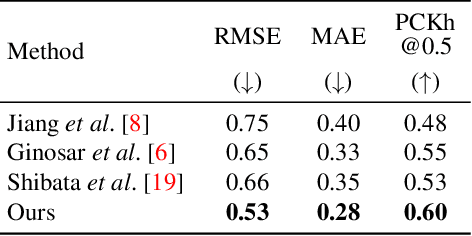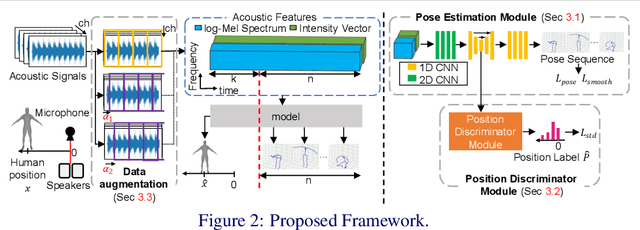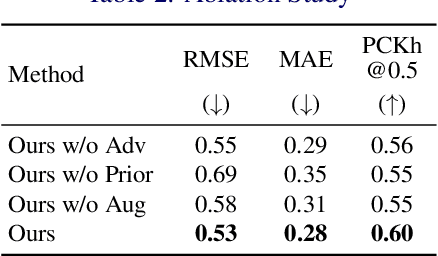Yoshimitsu Aoki
Language-Guided Contrastive Audio-Visual Masked Autoencoder with Automatically Generated Audio-Visual-Text Triplets from Videos
Jul 16, 2025Abstract:In this paper, we propose Language-Guided Contrastive Audio-Visual Masked Autoencoders (LG-CAV-MAE) to improve audio-visual representation learning. LG-CAV-MAE integrates a pretrained text encoder into contrastive audio-visual masked autoencoders, enabling the model to learn across audio, visual and text modalities. To train LG-CAV-MAE, we introduce an automatic method to generate audio-visual-text triplets from unlabeled videos. We first generate frame-level captions using an image captioning model and then apply CLAP-based filtering to ensure strong alignment between audio and captions. This approach yields high-quality audio-visual-text triplets without requiring manual annotations. We evaluate LG-CAV-MAE on audio-visual retrieval tasks, as well as an audio-visual classification task. Our method significantly outperforms existing approaches, achieving up to a 5.6% improvement in recall@10 for retrieval tasks and a 3.2% improvement for the classification task.
Iterative Event-based Motion Segmentation by Variational Contrast Maximization
Apr 25, 2025Abstract:Event cameras provide rich signals that are suitable for motion estimation since they respond to changes in the scene. As any visual changes in the scene produce event data, it is paramount to classify the data into different motions (i.e., motion segmentation), which is useful for various tasks such as object detection and visual servoing. We propose an iterative motion segmentation method, by classifying events into background (e.g., dominant motion hypothesis) and foreground (independent motion residuals), thus extending the Contrast Maximization framework. Experimental results demonstrate that the proposed method successfully classifies event clusters both for public and self-recorded datasets, producing sharp, motion-compensated edge-like images. The proposed method achieves state-of-the-art accuracy on moving object detection benchmarks with an improvement of over 30%, and demonstrates its possibility of applying to more complex and noisy real-world scenes. We hope this work broadens the sensitivity of Contrast Maximization with respect to both motion parameters and input events, thus contributing to theoretical advancements in event-based motion segmentation estimation. https://github.com/aoki-media-lab/event_based_segmentation_vcmax
Formula-Supervised Sound Event Detection: Pre-Training Without Real Data
Apr 06, 2025Abstract:In this paper, we propose a novel formula-driven supervised learning (FDSL) framework for pre-training an environmental sound analysis model by leveraging acoustic signals parametrically synthesized through formula-driven methods. Specifically, we outline detailed procedures and evaluate their effectiveness for sound event detection (SED). The SED task, which involves estimating the types and timings of sound events, is particularly challenged by the difficulty of acquiring a sufficient quantity of accurately labeled training data. Moreover, it is well known that manually annotated labels often contain noises and are significantly influenced by the subjective judgment of annotators. To address these challenges, we propose a novel pre-training method that utilizes a synthetic dataset, Formula-SED, where acoustic data are generated solely based on mathematical formulas. The proposed method enables large-scale pre-training by using the synthesis parameters applied at each time step as ground truth labels, thereby eliminating label noise and bias. We demonstrate that large-scale pre-training with Formula-SED significantly enhances model accuracy and accelerates training, as evidenced by our results in the DESED dataset used for DCASE2023 Challenge Task 4. The project page is at https://yutoshibata07.github.io/Formula-SED/
Simultaneous Motion And Noise Estimation with Event Cameras
Apr 05, 2025



Abstract:Event cameras are emerging vision sensors, whose noise is challenging to characterize. Existing denoising methods for event cameras consider other tasks such as motion estimation separately (i.e., sequentially after denoising). However, motion is an intrinsic part of event data, since scene edges cannot be sensed without motion. This work proposes, to the best of our knowledge, the first method that simultaneously estimates motion in its various forms (e.g., ego-motion, optical flow) and noise. The method is flexible, as it allows replacing the 1-step motion estimation of the widely-used Contrast Maximization framework with any other motion estimator, such as deep neural networks. The experiments show that the proposed method achieves state-of-the-art results on the E-MLB denoising benchmark and competitive results on the DND21 benchmark, while showing its efficacy on motion estimation and intensity reconstruction tasks. We believe that the proposed approach contributes to strengthening the theory of event-data denoising, as well as impacting practical denoising use-cases, as we release the code upon acceptance. Project page: https://github.com/tub-rip/ESMD
BoundMatch: Boundary detection applied to semi-supervised segmentation for urban-driving scenes
Mar 30, 2025Abstract:Semi-supervised semantic segmentation (SS-SS) aims to mitigate the heavy annotation burden of dense pixel labeling by leveraging abundant unlabeled images alongside a small labeled set. While current teacher-student consistency regularization methods achieve strong results, they often overlook a critical challenge: the precise delineation of object boundaries. In this paper, we propose BoundMatch, a novel multi-task SS-SS framework that explicitly integrates semantic boundary detection into the consistency regularization pipeline. Our core mechanism, Boundary Consistency Regularized Multi-Task Learning (BCRM), enforces prediction agreement between teacher and student models on both segmentation masks and detailed semantic boundaries. To further enhance performance and sharpen contours, BoundMatch incorporates two lightweight fusion modules: Boundary-Semantic Fusion (BSF) injects learned boundary cues into the segmentation decoder, while Spatial Gradient Fusion (SGF) refines boundary predictions using mask gradients, leading to higher-quality boundary pseudo-labels. This framework is built upon SAMTH, a strong teacher-student baseline featuring a Harmonious Batch Normalization (HBN) update strategy for improved stability. Extensive experiments on diverse datasets including Cityscapes, BDD100K, SYNTHIA, ADE20K, and Pascal VOC show that BoundMatch achieves competitive performance against state-of-the-art methods while significantly improving boundary-specific evaluation metrics. We also demonstrate its effectiveness in realistic large-scale unlabeled data scenarios and on lightweight architectures designed for mobile deployment.
Leveraging LLMs with Iterative Loop Structure for Enhanced Social Intelligence in Video Question Answering
Mar 27, 2025



Abstract:Social intelligence, the ability to interpret emotions, intentions, and behaviors, is essential for effective communication and adaptive responses. As robots and AI systems become more prevalent in caregiving, healthcare, and education, the demand for AI that can interact naturally with humans grows. However, creating AI that seamlessly integrates multiple modalities, such as vision and speech, remains a challenge. Current video-based methods for social intelligence rely on general video recognition or emotion recognition techniques, often overlook the unique elements inherent in human interactions. To address this, we propose the Looped Video Debating (LVD) framework, which integrates Large Language Models (LLMs) with visual information, such as facial expressions and body movements, to enhance the transparency and reliability of question-answering tasks involving human interaction videos. Our results on the Social-IQ 2.0 benchmark show that LVD achieves state-of-the-art performance without fine-tuning. Furthermore, supplementary human annotations on existing datasets provide insights into the model's accuracy, guiding future improvements in AI-driven social intelligence.
Text-guided Synthetic Geometric Augmentation for Zero-shot 3D Understanding
Jan 16, 2025



Abstract:Zero-shot recognition models require extensive training data for generalization. However, in zero-shot 3D classification, collecting 3D data and captions is costly and laborintensive, posing a significant barrier compared to 2D vision. Recent advances in generative models have achieved unprecedented realism in synthetic data production, and recent research shows the potential for using generated data as training data. Here, naturally raising the question: Can synthetic 3D data generated by generative models be used as expanding limited 3D datasets? In response, we present a synthetic 3D dataset expansion method, Textguided Geometric Augmentation (TeGA). TeGA is tailored for language-image-3D pretraining, which achieves SoTA in zero-shot 3D classification, and uses a generative textto-3D model to enhance and extend limited 3D datasets. Specifically, we automatically generate text-guided synthetic 3D data and introduce a consistency filtering strategy to discard noisy samples where semantics and geometric shapes do not match with text. In the experiment to double the original dataset size using TeGA, our approach demonstrates improvements over the baselines, achieving zeroshot performance gains of 3.0% on Objaverse-LVIS, 4.6% on ScanObjectNN, and 8.7% on ModelNet40. These results demonstrate that TeGA effectively bridges the 3D data gap, enabling robust zero-shot 3D classification even with limited real training data and paving the way for zero-shot 3D vision application.
Acoustic-based 3D Human Pose Estimation Robust to Human Position
Nov 08, 2024



Abstract:This paper explores the problem of 3D human pose estimation from only low-level acoustic signals. The existing active acoustic sensing-based approach for 3D human pose estimation implicitly assumes that the target user is positioned along a line between loudspeakers and a microphone. Because reflection and diffraction of sound by the human body cause subtle acoustic signal changes compared to sound obstruction, the existing model degrades its accuracy significantly when subjects deviate from this line, limiting its practicality in real-world scenarios. To overcome this limitation, we propose a novel method composed of a position discriminator and reverberation-resistant model. The former predicts the standing positions of subjects and applies adversarial learning to extract subject position-invariant features. The latter utilizes acoustic signals before the estimation target time as references to enhance robustness against the variations in sound arrival times due to diffraction and reflection. We construct an acoustic pose estimation dataset that covers diverse human locations and demonstrate through experiments that our proposed method outperforms existing approaches.
Pre-training with Synthetic Patterns for Audio
Oct 01, 2024Abstract:In this paper, we propose to pre-train audio encoders using synthetic patterns instead of real audio data. Our proposed framework consists of two key elements. The first one is Masked Autoencoder (MAE), a self-supervised learning framework that learns from reconstructing data from randomly masked counterparts. MAEs tend to focus on low-level information such as visual patterns and regularities within data. Therefore, it is unimportant what is portrayed in the input, whether it be images, audio mel-spectrograms, or even synthetic patterns. This leads to the second key element, which is synthetic data. Synthetic data, unlike real audio, is free from privacy and licensing infringement issues. By combining MAEs and synthetic patterns, our framework enables the model to learn generalized feature representations without real data, while addressing the issues related to real audio. To evaluate the efficacy of our framework, we conduct extensive experiments across a total of 13 audio tasks and 17 synthetic datasets. The experiments provide insights into which types of synthetic patterns are effective for audio. Our results demonstrate that our framework achieves performance comparable to models pre-trained on AudioSet-2M and partially outperforms image-based pre-training methods.
Data Collection-free Masked Video Modeling
Sep 10, 2024



Abstract:Pre-training video transformers generally requires a large amount of data, presenting significant challenges in terms of data collection costs and concerns related to privacy, licensing, and inherent biases. Synthesizing data is one of the promising ways to solve these issues, yet pre-training solely on synthetic data has its own challenges. In this paper, we introduce an effective self-supervised learning framework for videos that leverages readily available and less costly static images. Specifically, we define the Pseudo Motion Generator (PMG) module that recursively applies image transformations to generate pseudo-motion videos from images. These pseudo-motion videos are then leveraged in masked video modeling. Our approach is applicable to synthetic images as well, thus entirely freeing video pre-training from data collection costs and other concerns in real data. Through experiments in action recognition tasks, we demonstrate that this framework allows effective learning of spatio-temporal features through pseudo-motion videos, significantly improving over existing methods which also use static images and partially outperforming those using both real and synthetic videos. These results uncover fragments of what video transformers learn through masked video modeling.
 Add to Chrome
Add to Chrome Add to Firefox
Add to Firefox Add to Edge
Add to Edge